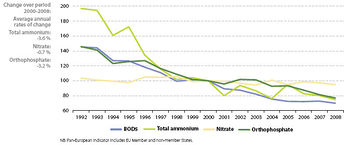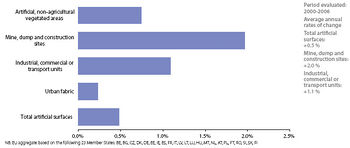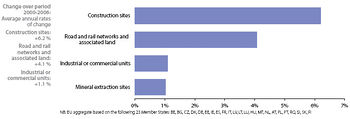Archive:Sustainable development - natural resources
- Data from July 2011, most recent data: Further Eurostat information, Database.
This article provides an overview of statistical data on sustainable development in the area of natural resources. They are based on the set of sustainable development indicators the European Union (EU) agreed upon for monitoring its sustainable development strategy. Together with similar indicators for other areas, they make up the report 'Sustainable development in the European Union - 2011 monitoring report of the EU sustainable development strategy', which Eurostat draws up every two years to provide an objective statistical picture of progress towards the goals and objectives set by the EU sustainable development strategy and which underpins the European Commission’s report on its implementation. More detailed information on natural resources indicators, such as indicator relevance, definitions, methodological notes, background and potential linkages, can be found in the publication mentioned above, p. 281-305.
The table below summarises the state of affairs of in the area of natural resources. Quantitative rules applied consistently across indicators, and visualised through weather symbols, provide a relative assessment of whether Europe is moving in the right direction, and at a sufficient pace, given the objectives and targets defined in the strategy.
Overview of main changes
Changes in the natural resources theme since 2000 show both favourable and unfavourable trends. On the one hand, there has been continued progress in the designation of protected areas and in water quality, and the harvesting of wood from forests remains sustainable. The abundance and diversity of common birds have stabilised, albeit in a substantially poorer state than they were in 1990 and previous decades. On the other hand, marine fish stocks remain under threat and built-up land continues to increase at the expense of areas of seminatural land.
Main statistical findings

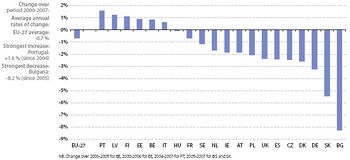
Headline indicators
Abundance of common birds
The EU index for all common birds has stabilised between 2000 and 2008, after experiencing sharp decreases between 1990 and 2000
- A stabilisation in common bird population has begun
The common bird index combines information on the diversity and abundance of common bird species. Apart from human impacts on habitats, bird populations fluctuate from year to year due to complex interactions with other species and environmental factors such as food supply and climatic conditions. Consequently trends can only be derived from observations over a long period of time.
Between 1990 and 2000 the index of all common birds for 19 Member States showed a steep decline of 1.3 % per year on average. Since 2000 there have been signs of recovery. Observed common bird population diversity and abundance during that period has been growing with an average of 0.5 % yearly. Among the species that have shown some increase, habitat generalists are well represented. Species that have increasing trends also include some specialist forest species (such as the Blackcap), the Eurasian Collared Dove, the Common Buzzard and the Common Raven; both Buzzard and Raven are recovering from past declines [1].
- But abundance of common farmland birds is still declining
In contrast, the population of farmland birds, which is a subcategory of common birds, has continued to decline, albeit at a lower rate in recent years. Between 1990 and 2000, the farmland bird index fell by 1.4 % per year on average. Since then the annual rate of decline has fallen to about 0.7 %. The population of farmland birds in the Member States that were part of the 2004 and 2007 EU enlargements which were previously performing better are now, increasingly, catching up with the declining trends of the rest of the EU. Intensification of agricultural practices and the ensuing deterioration and conversion of suitable habitats appear to be among the main drivers behind these trends [2].
A decline in the common farmland bird index took place in many of the 20 Member States for which information is available. Bulgaria, Slovakia and Germany show the highest annual average rates of decline, whilst Portugal, Latvia and Finland show the most positive trends.
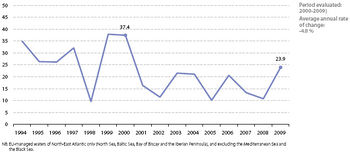
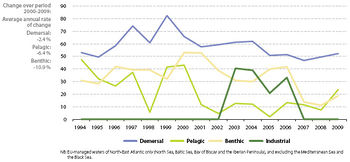
Conservation of fish stocks
Between 2000 and 2009 the proportion of total fish catches taken from North East Atlantic stocks outside safe biological limits declined moderately. However, in 2009 the share of fish catches outside safe biological limits was still close to 24 %
- Fish stocks continue to be threatened by overfishing
Despite temporary improvements in 2002 and 2005, 23.9 % of total fish catches in 2009 were from stocks outside safe biological limits, and catches of all categories of non-industrial fish considerably exceeded sustainable levels of exploitation.
Total catches taken from stocks outside safe biological limits declined to close to 10 % in 2005. However, due to a sharp increase in unsustainable catches, especially of pelagic fish (which live in the open sea), and the constant high value for demersal fish (which live on or close to the sea bed), total fish catches from stocks outside safe biological limits again exceeded the 20 % mark in 2009. Total fish stocks remain threatened by overfishing in the North East Atlantic.
- Half of the catches of demersal fish in 2009 were unsustainable
Although slowly declining, unsustainable catches of demersal fish (which live on or close to the sea bed) show the highest rate among total fish catches with 62 % in 2004 and over 50 % in 2009. Fishing of pelagic (open sea species) stocks above sustainable levels decreased considerably between 2000 and 2005 but has since risen again to 23.7 %. Overfishing of benthic stocks has been on track towards safe levels since 2000, almost reaching 10 % in 2008. Industrial fish stocks have reached sustainable levels of fishing since 2007.
- Fishing quotas do not always reflect scientifically defined sustainable amounts of catches
It is difficult to establish clear links between these figures and yearly fishing quotas, or Total Allowable Catch (TAC) per species, area and time, because the stocks of specific species are not only influenced by catches of that species, but also of species on which they depend in the food web. In the EU, the TAC of many common fish species is agreed by the Council of Ministers. Fixed shares of TAC are distributed among the Member States based on historical shares of catches, which is in turn directly related to fishing capacity and fleet size (see indicator on fishing capacity below). It can nevertheless be noted that despite the fact that the decision making process concerning TACs foresees the inclusion of scientific advice, a 2008 Commission Communication observed that the TACs decided by the Council have on average been 48 % higher than the scientifically defined sustainable levels (based on a precautionary approach)[3].
Biodiversity
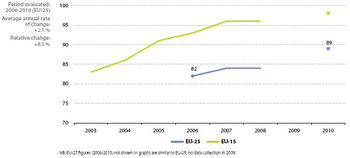

Protected areas
Between 2006 and 2010 the area designated for nature conservation in the EU-25 grew steadily, reaching a level of 89% of that considered sufficient
- Seven Member States have already achieved 100 % sufficiency and ten others are over 90% sufficient
The establishment of Natura 2000 sites is an important pillar of the EU’s efforts to halt the loss of biodiversity. The sufficiency of designated areas in the EU-15 rose steadily from 83 % in 2003 to 98 % in 2010. For the EU-25, the sufficiency of designated areas rose from 82 % to 89 % between 2006 and 2010.
Belgium, Denmark and the Netherlands, who had already achieved 100 % sufficiency by 2008, have been joined by Greece, Luxembourg, Sweden and the United Kingdom in 2010. A further ten Member States are over 90 % sufficient, Cyprus is the only Member State below 50 %. By far the largest increase from 2008 to 2010 has been in Poland (from 17 % to 78 %).
In interpreting the sufficiency of sites designated as an indicator of the status of protected areas in the EU, two aspects should nevertheless be kept in mind. Firstly, this indicator shows the progress towards the full designation of areas that qualify for protection under the Habitats Directive. Variations between Member States exist regarding the total area that can potentially be designated, depending on the presence of specific vulnerable habitats and species targeted by the Directives. Secondly, and more importantly, the indicator refers to the designation of areas, in terms of area covered, not yet to their actual protection, i.e. management ensuring the effective conservation of habitats and species. As revealed by the 2009 Commission report on the conservation status of habitats and species under the Habitats Directive, nearly 65 % of the protected habitats and 52 % of protected species are in an unfavourable conservation status [4]. The assessment for species found in grasslands, agricultural and coastal areas is even more negative.
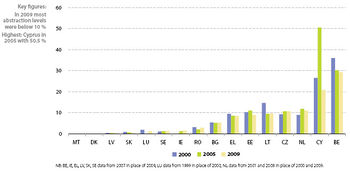
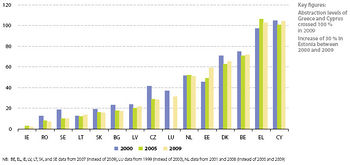
Freshwater resources
Water abstraction
In nearly all Member States for which data are available, water abstraction remained at a sustainable level, and many countries appear to have stabilised abstraction pressure on water resources between 2000 and 2009
- Water abstraction levels are generally within sustainable limits
The share of total annual water abstraction from available renewable water resources, including surface and groundwater, gives an indication of the pressure on the long-term annual average of renewable water resources. The groundwater available for annual abstraction is defined as the recharge, i.e. water moving from surface to groundwater, less the long-term annual average rate of flow, i.e. water moving from ground to surface water, required to achieve ecological quality objectives for associated surface water.
The consumption of both surface and groundwater is driven by four main economic activities: cooling in electricity production; public water supply; the manufacturing industry; and agriculture, forestry and fishing. Overall, 44 % of the total abstracted water is for energy production, 24 % for agriculture, 21 % for public water supply and 11 % for industry. These figures vary significantly across the Member States for which data is available. In southern counties agricultural water abstraction accounts for 60 % of the total [5].
From 2000 to 2009, overall, annual surface water abstraction either remained relatively stable in most Member States for which data is available. Only Cyprus experienced a considerable increase in surface water abstraction, reaching 50.5 % of renewable resources in 2005, which, however, levelled off to about 21 % in 2009.From 1990 to 2000, annual surface water abstraction either decreased or remained relatively stable in most Member States. This trend continued from 2000 to 2007, during which only Cyprus experienced a significant increase in surface water abstraction, reaching 38 % of renewable resources in 2004, which, however, levelled off to about 29 % in 2007. Romania, which at about 44 % had by far the highest level of abstraction in 1990, reduced its abstraction to 21 % in 2000 and to 16 % in 2007.
- Some Member States show unsustainable levels of groundwater abstraction
Groundwater abstraction remained relatively stable between 2000 and 2009 in most Member States for which data are available. Several countries still show high or, in the case of Greece and Cyprus, unsustainable groundwater abstraction levels in 2009. Groundwater abstraction in Greece peaked at around 106 % in 2005. A considerable increase, of more than 30 %, in abstraction levels can be observed in Estonia between 2000 and 2009.
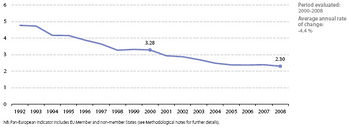
Water quality in rivers
Between 2000 and 2008 the annual mean concentration of biochemical oxygen demand has decreased in European rivers, indicating a favourable increase in water quality
- Water quality in European rivers has improved both before and after 2000
Biochemical oxygen demand (BOD) estimates the total amount of biodegradable organic matter in a system and is a commonly used indicator of water quality: the lower the BOD, the higher the water quality. There has been a favourable decrease in BOD across rivers in Europe over the entire period for which data are available. Biochemical oxygen demand in European rivers fell from a mean level of 3.3 mg/l in 2000 to 2.3 mg/l in 2008. This trend is indicative of the improvement in waste water treatment following the 1991 Urban Wastewater Directive [6] and possibly to decreasing nitrate emissions from agriculture.
- Water quality in rivers has improved
The trends in BOD are mirrored by other, more specific, measurements of water quality, such as ammonium, nitrate and phosphate.
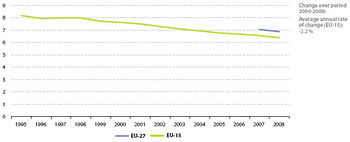
Marine ecosystems
Fishing capacity
Despite the continuous decrease in EU fishing fleets, as measured by the total engine power of fishing vessels, progress in fishing efficiency means that fishing capacity is still too high for the available fish stocks
- Whilst the total engine power of fishing fleets has declined, fishing capacity is still too high to sustain stocks
The EU-15 fishing fleet, as measured by the total engine power of fishing vessels, decreased by 2.28 % on average per year from 1995 to 2000. From 2000 to 2008 the average annual rate of decrease declined to 1.64 %. According to the Green Paper on the Reform of the Common Fisheries Policy [7], these decreases may well have been offset by technological progress which is estimated to increase fishing efficiency by approximately 2-3 % per year [8]. The imbalance between the fleet and available fish stocks has therefore not been redressed, resulting in reduced landings and a heavier reliance of the EU market on imports. One instrument used by the EU to manage fishing activity is the issuing of fishing quotas or Total Allowable Catch (TAC) (usually per species/ year/ region/ Member State), compliance with which is monitored at landing. The adverse effects of fishing quotas have however gained publicity as one of the drivers of the discards problem, i.e. throwing overboard of by-catches or surplus fish catches.
Land use
Increase in build-up land
During the period from 2000 to 2006 artificial surfaces as a whole grew in the EU. The main increases were in sites for mining, dumping and construction
- Artificial surfaces are increasing at the expense of semi-natural and agricultural land
Built-up land is continuously encroaching on farmland and semi-natural land. The category ‘mine, dump and construction sites’ experienced the highest rate of growth. This is accounted for by an annual rate of increase of construction sites of 6.2 %. It is particularly significant that road and rail networks showed the second highest growth rate (4.1 % annual average growth rate) as well as an increase of this rate compared to the 1990-2000 period. The fragmentation of ecosystems associated with such extensive linear structures is a major pressure on biodiversity, limiting the range available to animals for migration, exchange of genetic material between populations, breeding or finding food.
The entire scope of degradation and conversion of natural land is greater than what can be reflected by the indicators presented here. Two additional factors need to be taken into consideration, namely the critical increase of pressure on ecosystems and species applied by both the effects of the intensification of agriculture and the conversion of high value natural areas to farmland. If natural areas and ecosystems become too small, they might stop delivering their services, such as the provision of clean air and water, water retention and carbon intake. Also, more indirect effects of the increase of artificial surfaces include the disturbance of hydrological processes leading for example to increased soil erosion by water (due to larger volumes of run-off on impermeable surfaces) and consequently to a deterioration of water quality.
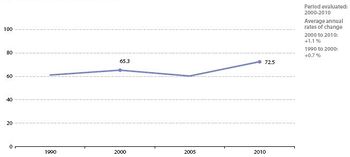
Forest increment and fellings
In 2010 the forest utilisation rate remained well within the sustainability threshold of 100%
- Fellings remain sustainable
Whereas fellings increased slightly between 2000 and 2010, increment fell considerably over the same period. This is reflected in a substantial increase in the forest utilisation rate (the ratio between fellings and increment). This increase in the forest utilisation rate can be seen in both a positive and negative light. One positive aspect is that if older trees are removed it reduces the vulnerability of forests to fires and disease. However, it also means that there is less growing stock for future utilisation.
- Despite two years of decline, the longterm trend is for increased removals
The European Union is a major wood producer. Demand for construction materials, wood fibre, other wood products, and biomass, as well as exports, are the most important drivers of this production. Although removals fell slightly between 2000 and 2009, the trend up to 2007 was for increasing removals, and it was only the substantial falls in 2008 and 2009, reflecting the fall in demand for construction materials and other wood products as a result of the economic crisis, which took removals below the level of 2000. Over the previous period, from 1993 to 2000, removals in the EU-27 increased rather rapidly.
The especially sharp increases in 2000 (10.3 %), 2005 (7.4 %) and 2007 (9.7 %) were due to timber which fell in severe storms affecting some regions of Europe.
Further Eurostat information
Publications
- Sustainable development in the European Union - 2011 monitoring report of the EU sustainable development strategy
- Forestry in the EU and the world: A statistical portrait - 2011 edition
- Eurostat news release Land Use/Cover area frame Survey: Results on EU land cover and use published for the first time, 4 October 2010
Database
- Indicators
- Natural Resources
Dedicated section
Other information
- Our life insurance, our natural capital: an EU biodiversity strategy to 2020, Commission communication COM(2011) 244
- Facts and figures on the Common Fisheries Policy - 2010 Edition, European Commission, Luxembourg, Office for Official Publications of the European Union, 2010
- Assessing biodiversity in Europe - the 2010 report, EEA report No. 5/2010, Luxembourg, Office for Official Publications of the European Union, 2010
- EU 2010 Biodiversity Baseline, EEA technical report No. 12/2010, Luxembourg, Office for Official Publications of the European Union, 2010
- The European Environment - state and outlook 2010
- The Economics of Ecosystems and Biodiversity (TEEB) reports
External links
See also
- Agri-environmental statistics
- All articles on sustainable development indicators
- Biodiversity statistics
- Environmental Data Centre on Natural Resources and Products
- Water statistics
Notes
- ↑ Pan-European Common Bird Monitoring Scheme The state of Europe’s common birds 2007, CSO/RSPB, Prague, 2007
- ↑ BirdLife International Europe-wide monitoring schemes highlight declines in widespread farmland birds, 2011
- ↑ Commission communication, Fishing Opportunities for 2009: Policy Statement from the European Commission, COM(2008) 331.
- ↑ Commission report Composite Report on the Conservation Status of Habitat Types and Species as required under Article 17 of the Habitats Directive, COM(2009) 358
- ↑ European Environment Agency, Water resources across Europe – confronting water scarcity and drought, EEA Report No 2/2009, Publications Office of the European Union, Luxembourg, 2009
- ↑ Council Directive 91/271/EEC concerning urban waste-water treatment
- ↑ Commission Green Paper Reform of the Common Fisheries Policy, COM(2009)163
- ↑ Banks, R., Cunningham, S., Davidse, W.P., Lindebo, E., Reed, A., Sourisseau, E. and De Wilde, J.W., The impact of technological progress on fishing effort, Report prepared for the European Commission, 2002


